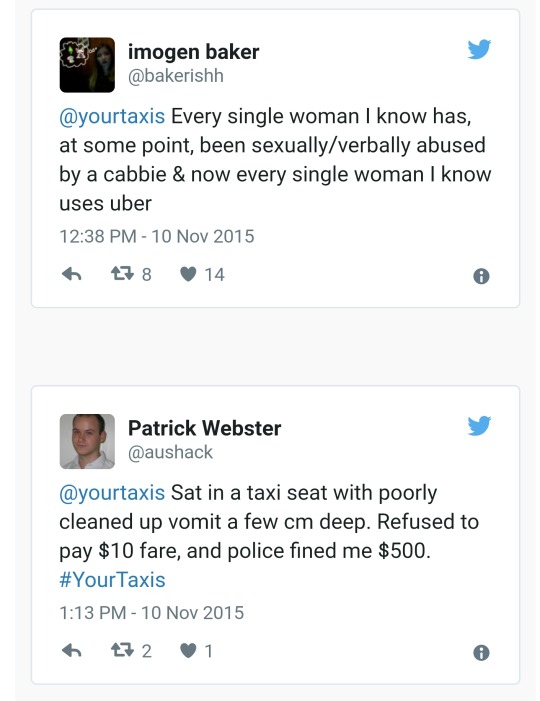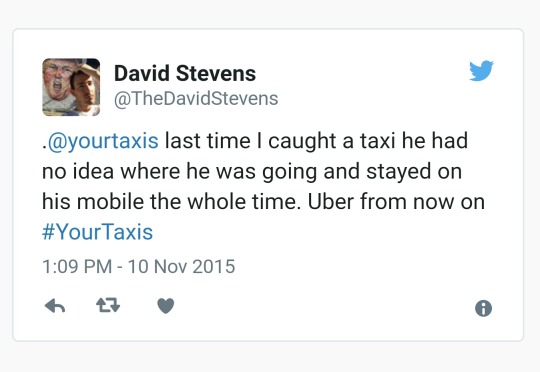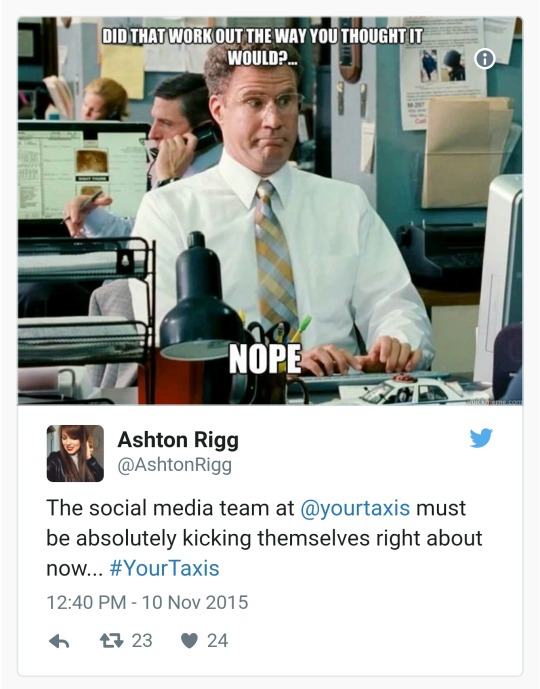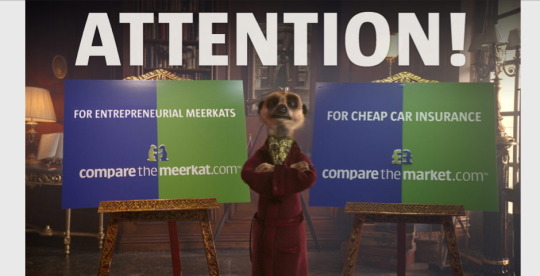catecampbell92-blog
2 posts
Don't wanna be here? Send us removal request.
Text
@YourTaxis - Not a smooth ride
There is no denying that being a taxi driver is a tough job. The long hours, the early mornings, late nights, not to mention the 3am pick ups and drop offs. The one thing that the industry had going for them, at least until recently, was a monopoly on the market. Theirs was a service that was a necessity, and because there was no other alternative, they could relax standards, on cleanliness, friendliness and even competence. But that was then, and this is now, Now with the affordances provided to us by technological convergence, we have a myriad of option for our transportation needs. Companies like Uber, GoCatch and Lyft to name a few have been eating into the taxis market. These are a peer-to-peer driven services, created by the people for the people. And it’s no wonder that in 2014 the Victorian Taxi Association (VTA) launched a social media campaign to try and generate some positive PR around the industry and lure consumers back to their services. Unfortunately for them, it was a complete fail.
“There is no doubt that #YourTaxis will go down as the Australian marketing fail of the year” wrote Mark Witson (2015) from the Sydney Morning Herald. And that about sums up the VTA’s disastrous social media marketing campaign. The @yourtaxi campaign was supposed to give commuters a platform to share their (positive) taxi experiences. Using the hashtages #yourtaxis and #taxiyourway and newly established twitter account @yourtaxis, VTA encouraged its customers to share stories of their taxi experiences. However, what started as a good PR idea soon turned into a PR nightmare. The hashtags and account (which has now been deactivated) were inundated with tweets from dissatisfied customers, sharing their horror stories or reasons why they were using alternative services such as Uber.


So where did VTA go so wrong? E. Cassidy (2017a) claims one of the general considerations when designing social media campaign is having a clear purpose. This the VTA did actually have. They wanted to counter the popularity of other ride sharing companies, companies they rely heavily on social media. And they wanted to use social media as many of the customers who are moving away from traditional taxi services are doing so because they are competent social media users. Therefore by creating a campaign that utilizes social media, they would be targeting the audience of consumers who are moving to other ride sharing services. However, VTA’s first and biggest error was in their research. They failed to understand their audience. Public sentiment towards taxis in Victoria was on the steady decline and therefore VTA made a grave error in allowing the public to create and share content.
Thanks to the many affordances given to us by technological convergence, society is not more connected than ever before. We are living in a Mediapolis, ‘a comprehensively mediated public space where media underpin and overarch the experiences and expressions of everyday life’ (Deuze, 2011:137) and these technological convergence affordances has enabled paradigm shift of media consumption from top-down communication, to bottom up communication (Cassidy, 2017b). Audiences now have the ability to choose when were and through what devices they access media and are able to make demands of larger companies and organisations. And, most notably, they want to get involved in social media content production, consumption and distribution (Cassidy, 2017b). VTA failed to understand the power of networked publics, just one of the affordances given to us through technological convergence. These are audiences that are constructed by networked technologies’ (Boyd, 2011). Boyd (2011) goes on to claim that as such networked publics are ‘simultaneously 1) the space constructed through networked technologies and 2) the imagined collective that emerges as a result of the intersection of people, technology and practice’. Through technological affordances these networked publics can create dynamics that help shape people’s behaviour (Cassidy, 2017b). In this case, the public sentiment quickly shifted from VTA’s goal of sharing positive taxi experiences, to giving angry, dissatisfied consumers a platform to publicly air their grievances.
Most marketing companies strive for high consumer interaction, which can lead to the social media phenomenon known as ‘going viral’. Viral content is so called because it spreads like a biological viral epidemic. And with technological convergence, the possibilities for potential audiences are almost endless. The content is often produced from the top down, that is by big companies, but it is spread from the bottom up, by consumers of media content (Cassidy, 2017b). However, while the YourTaxis campaign did achieve viral status, it was not through positive social media interactions and VTA did not have an adequate contingency plan for if things went wrong. A good response framework should include pre-prepared answers to projected FAQs, which is especially important for real-time consumer engagement (Cassidy, 2017a). And when things go wrong, as in the case of YourTaxis, the first step is to acknowledge the failure, then respond accordingly, including an apology (Cassidy, 2017a).
Failing to understand the power of networked publics, underestimating the spreadability of viral content and not having an adequate contingency plan are just some of the main reasons why VTA’s YourTaxi campaign gained traction for all the wrong reasons. So what could they have done differently? After all, the idea itself, allowing consumers to share and interact with VTA and with each other, could have been a positive marketing campaign. Audiences like to feel included and enjoy engaging with one another, that is one of the cornerstones of social media itself.
So, addressing VTA’s first mistake; giving a platform to disenfranchised customers. Before attempting an interactive social media campaign, VTA should have run a positive PR campaign, with the exclusive purpose of changing customer sentiment. This could have been done through a series of media content such as anecdotal videos; which profiled good taxi drivers and positive customer experiences. Perhaps focusing on a taxi driver who came to Australia as a refugee and now relies on driving his taxi to put his children through university. Importantly showing the human side to the taxi industry, the men and women who sit behind the wheel day in and day out, and who rely on the income to support their families. Thus giving the public something they can relate to and would perhaps be willing to engage with, through liking, sharing, commenting etc. The content should have been distributed through cross media distribution (the same content across multiple channels) focusing on the most popular channels of facebook, instagram and twitter for greatest audience engagement. Simultaneously, VTA should have run a PR campaign on how they were improving the standard of their taxi services. Encompassing everything from cleanliness to driver competence. Only when they felt that the public sentiment was shifting in their favour should they have attempted a completely interactive social media campaign. In fact, many would argue that whilst the campaign was a good idea in theory, there were still too many risks to launching a PR campaign of this type.
Where VTA failed next was their response and lack of contingency plan. Instead of acknowledging the PR failure, Samuel Davis VTA chief executive insisted “the response online over the past 24 hours isn't anything we didn't expect. We asked for feedback and we got it. The good and the bad and everything in between” (cited in Ross, 2015). The longer the YourTaxis campaign ran the further it got away from its original goal, and by not acknowledging and responding appropriately to customer complaints, the conversation online expanded from bad anecdotes of taxi experiences, to laughing at the social media campaign itself.

VTA should have come out and publically acknowledged the PR mistake, apologized to the disgruntled customers and most importantly showed how they would address the complaints raised through the campaign.
But let’s say they did all this, and the results were the same, what the VTA should have done was run a follow up PR campaign, perhaps using humour to acknowledge the flaws of the first campaign, but then demonstrating how the concerns raise by customers were being addressed. By doing this, they are showing that they value their customers, are willing to listen and adapt to their concerns, fostering an ‘inclusionary vibe’ which demonstrates attention to consumer input (Cassidy, 2017c). The fashion designer Tom Ford (as cited in Ritson, 2015) once said “the right thing at the wrong time… is still the wrong thing”. This is very true of the YourTaxi campaign, however if the VTA had implemented a few of the steps outlined above, perhaps the damage would have been less severe.
Reference:
Boyd, Danah. 2011. “Social Network Sites as Networked Publics – Affordances, Dynamics, and Implications.” In A Networked Self – Identity, Community, and Culture on Social Network Sites edited by Zizi Papacharissi, 39-58. New York: Routledge.
Cassidy, Elijah. 2017a. Week 8 Lectorial. MP3 Podcast. Accessed May 20, 2017 https://lecturecapture.qut.edu.au/ess/lti/v1/launch/BLACKBOARD/90e0f566-3969-40ff-8600-e7cac2c2e219
Cassidy, Elijah. 2017b. Week 2 Lectotial, Social Media Self and Society. MP3 Podcast. Accessed March 24, 2017 https://lecturecapture.qut.edu.au/ess/lti/v1/launch/BLACKBOARD/90e0f566-3969-40ff-8600-e7cac2c2e219
Cassidy, Elijah. 2017c. Week 5 Lectorial, New Media Enterprises. MP3 Podcast. Accessed May 25, 2017 https://lecturecapture.qut.edu.au/ess/lti/v1/launch/BLACKBOARD/90e0f566-3969-40ff-8600-e7cac2c2e219
Davis, Samuel. 2014. Cited in “#Yourtaxis: Social media campaign by Victorian Taxi Association backfires as Melbourne users share horror stories” by Ross, Monique. Accessed May 30, 2017 from http://www.abc.net.au/news/2015-11-10/vic-taxis-campaign-backfires/6927626
Deuze, Mark. 2011 “Media Life.” Media, Culture & Society 33 (1): 137 - 148.
Jacka, Mike and Scott, Peter. 2011. Auditing Social Media: A Governance and Risk Guide. Barnes and Nobel Publishing.
Ford, Tom. (Unknown). Cited in “How #YourTaxis got it so very, very wrong” by Ritson, Mark. Accessed May, 29 2017 from http://www.smh.com.au/business/media-and-marketing/how-yourtaxis-got-it-so-very-very-wrong-20151110-gkvp7i.html
Ritson, Mark. 2015. “How #YourTaxis got it so very, very wrong”. Accessed May 29, 2017 from http://www.smh.com.au/business/media-and-marketing/how-yourtaxis-got-it-so-very-very-wrong-20151110-gkvp7i.html
0 notes
Text
Social Media. Does it ad up?
It is no secret that technology is shaping the world around us (Cohn, 2010). The convergence of ‘new’ and ‘old’ technologies has lead to the emergence of what is commonly known ‘New Media’ which, in turn, has enabled the rise of social media. New media can be seen as assemblages of artefacts, practices and social arrangements (Cassidy, 2017). Jacka and Scott (2011, 5) argue that due to the ever changing nature of technology there is ‘no one recognised definition for social media’ however, they offer ‘social media is the set of Web- based broadcast technologies that enable the democratization of content, giving people the ability to emerge from consumers of content to publishers’ as one of its many definitions (Jacka and Scott, 2011, 5). Social media is used ‘prolifically by all areas of society; business, politics, media, advertising, police and emergency services’ (Jacka and Scott, 2011, 6). Today we will particularly look at the impact that new media and social media has had on the advertising industry and how advertising agencies are utilising the new opportunities afforded them by the techno-social age we live in.
One of the many affordances provided by social media and new media is the rise of networked publics. Networked publics are ‘publics that are constructed by networked technologies. As such, they are simultaneously, 1) constructed through networked technologies and 2) the imagined collective that emerges as a result of intersection of people, technology and practice’ (Boyd, 2011). These networked publics provide advertising agencies many opportunities to target consumers and gather information on their online activities. Andrejevic (2013) gives an example, ‘if you download an application for surfing or knitting, you have simultaneously joined a new demographic group for the purposes of target marketing’. The capture of personal information is used to create targeted marketing campaigns, the online marketing model has created a market in feedback commodities. In some cases, this information is used directly by interactive companies to customize advertising; in others, it is bought and sold to marketers. For example Facebook sells its users’ data to third party advertisers and in this way generates much of its revenue (Schultz, 2013). Some critics claiming that companies are exploiting participants of social media, as they are generating a commodity (data) for free and are not being compensated, therefore what is classified as ‘labour’ and what is classified as user participation has become increasingly blurred.
Closely linked to networked publics is the rise of empowered new media audiences. Whereby the audience is not merely a passive observer, rather an active participant in content creation, distribution and consumption (Cassidy, 2017). One such example in the advertising industry is Doritos Superbowl advertisement competition. In this example everyday people are asked to create and produce an advertisement for Doritos. The winner was selected by public voting from a pool of 50 semifinalists and 3 finalists with participants vying for a cash prize of one million dollars and the opportunity of having their advertisement aired at the Superbowl. Here we see what is known as a participatory culture, where the consumers of the advertising material are also the producers and we see a blurring of many traditional media consumption lines. Where as traditional advertising models saw the audience as a passive consumer of content, such as a simple television ad or promotional poster, in this form of advertising, the consumers are not only interacting with the advertisement (through ‘liking’, sharing or commenting etc) they are producers of the content. There is a redistribution of power, a shift from one way top-down communication to a two way, bottom up model, also known as decentralization (Cassidy, 2017). Critics argue that this leads to exploitation, as Doritos is essentially getting consumers to ‘do their work for them’. Instead of paying an advertising agency to create an advertisement, they are essentially getting their consumers to create advertisements with only the winner receiving financial compensation. Further criticisms include that it leads to inequality and social divides, those who don’t have the motivation or skills to use or engage with new technologies are often neglected. However, conversely, others argue that the empowerment of new media audiences gives consumers more power and a say in what content they engage with (Cassidy, 2017).

An often sort after, yet highly elusive and unpredictable goal within the advtertising business is the phenomenon known as ‘going viral’. Viral content is so called because it spreads like a biological viral epidemic. And with technological convergence, the possibilities for potential audiences are almost endless, making it a highly effective advertising strategy. The content is often produced from the top down, that is by big companies, but it is spread from the bottom up, by consumers of media content (Cassidy, 2017). The advertisement creator relies on the consumer to like, share or interact with the content therefore meaning that it is extremely hard to strike upon an advertising campaign that will inspire people to voluntarily share and interact with the content. One such example of a viral advertisement campaign is that of Aleksandr Orlov and the Compare the Market (or Meerkat) phenomenon. Compare The Market is an online platform used to compare insurance products. Compare The Meerkat is a campaign revolving around a fictional family of Russian meerkats who have launched an advertising campaign to explain the difference between comparethemarket.com and comparethemeerkat.com. Assisting the success of this marketing campaign was Compare the Market’s use of transmedia. Instead of simply pushing content through one media mode, they instead took advantage of technological convergence affordances and provided multitextual engagement opportunities for their consumers. Unlike crossmedia content, where the same content is pushed across different media platforms, transmedia content transmits different content across multiple platforms to create a story. This process is often non-linear and requires active audience participation (Cassidy, 2017). While Compare the Market is selling insurance, they have created a whole background story for the star of their campaign, Aleksandr Orlov the meerkat. People can follow and engage with Aleksandr and his family and all their struggles in trying to educate people about compare the market through many different media platforms. In fact, despite the popularity that the compare the meerkat campaign has brought to compare the market, compare the market has only 5,936 followers in comparison to Aleksandr who has over 66 thousand followers . Aleksandr’s account intersperses funny quirky tweets, with subtle advertisements, showing the blurring of the lines between entertainment and advertisement consumption.

Technological convergence, New Media and Social media mean that more and more we are living in a Mediapolis, ‘a comprehensively mediated public space where media underpin and overarch the experiences and expressions of everyday life’ (Deuze, 2011:137). It is impossible to exist in a world in which you do not engage with social media in some way. These new affordances provide opportunities and challenges in equal measure for those working in the advertisement industry. While consumers have easier access to content than ever before, the amount of content is greater than ever before, meaning that actually reaching and influencing the consumer is becoming more of a challenge. Furthermore ethical issues arise over the use of data mining, privacy and ‘unwaged labour’. Baym (2011,21) sums it up perfectly when he says ‘New media are constantly developing, new populations are taking up these tools, and new uses are emerging. Who is excluded from or enabled by digitally mediated interaction is neither random nor inconsequential…It is too soon to tell what the final consequences will be, but it seems unlikely that they will ever be universal or stable’.
References:
Andrejevic, Mark. 2013. “Estranged free labor”. “Digital labor: the internet as playground and factory” edited by Treber Schultz.
boyd, danah. 2011. “Social Network Sites as Networked Publics – Affordances, Dynamics, and Implications.” In A Networked Self – Identity, Community, and Culture on Social Network Sites edited by Zizi Papacharissi, 39-58. New York: Routledge.
Baym, Nancy. 2010. “Ch 1: New Forms of Personal Connection.” In Personal Connections in the Digital Age, 1 - 21. Cambridge MA: Polity Press.
Cassidy, Elijah. 2017. Week 2 Lectotial, Social Media Self and Society. MP3 Podcast. Accessed March 24, 2017 https://lecturecapture.qut.edu.au/ess/lti/v1/launch/BLACKBOARD/90e0f566-3969-40ff-8600-e7cac2c2e219
Cohn, Michael. 2010. The Impact of Social Media on Advertising. Retrieved from http://www.compukol.com/the-impact-of-social-media-on-advertising/ on 3/03/2017.
Deuze, Mark. 2011 “Media Life.” Media, Culture & Society 33 (1): 137 - 148.
Jacka, Mike and Scott, Peter. 2011. Auditing Social Media: A Governance and Risk Guide. Barnes and Nobel Publishing.
Schultz, Treber. 2013. “Digital Labor: The Internet as Playground and Facotry.”
0 notes